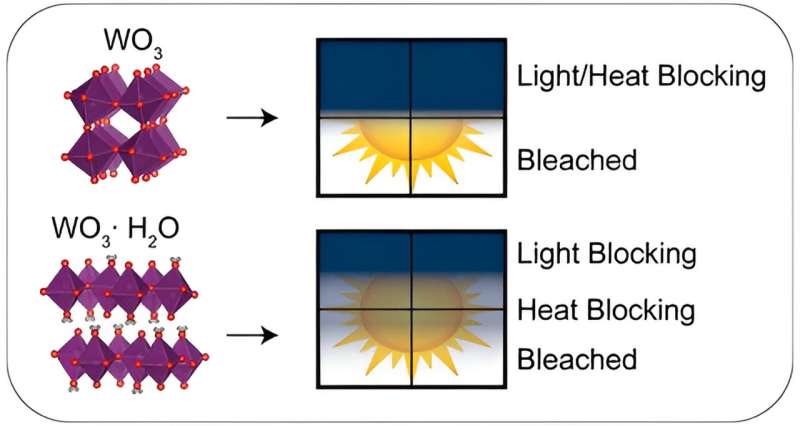This article has been reviewed according to Science X's editorial process and policies. Editors have highlighted the following attributes while ensuring the content's credibility:
fact-checked
peer-reviewed publication
trusted source
proofread
Material would allow users to 'tune' windows to block targeted wavelengths of light

Researchers have demonstrated a material for next generation dynamic windows, which would allow building occupants to switch their windows between three modes: transparent, or "normal" windows; windows that block infrared light, helping to keep a building cool; and tinted windows that control glare while maintaining the view.
Dynamic windows based on electrochromism—meaning their opacity changes in response to electric stimulus—are not a new concept. But, to this point, most dynamic windows were either clear or dark.
"Our work demonstrates that there are more options available," says Veronica Augustyn, co-corresponding author of a paper on the work and the Jake and Jennifer Hooks Distinguished Scholar in Materials Science and Engineering at North Carolina State University. "Specifically, we've shown that you can allow light to pass through the windows while still helping to keep buildings cooler and thus more energy efficient."
The paper, "Dual-Band Electrochromism in Hydrous Tungsten Oxide," is published in the journal ACS Photonics.
The key to more dynamic window materials is water.
Specifically, the researchers found that when water is bound within the crystalline structure of a tungsten oxide—forming tungsten oxide hydrate—the material exhibits a previously unknown behavior.
Tungsten oxides have long been used in dynamic windows. That's because tungsten oxide is normally transparent. But when you apply an electrical signal, and inject lithium ions and electrons into the material, the material becomes dark and blocks light.
Researchers have now shown that you can effectively tune the wavelengths of light that are blocked when you inject lithium ions and electrons into a related material called tungsten oxide hydrate. When lithium ions and electrons are injected into the hydrate material, it first transitions into a "heat blocking" phase, allowing visible wavelengths of light to pass through, but blocking infrared light. If more lithium ions and electrons are injected, the material then transitions into a dark phase, blocking both visible and infrared wavelengths of light.
"The presence of water in the crystalline structure makes the structure less dense, so the structure is more resistant to deformation when lithium ions and electrons are injected into the material," says Jenelle Fortunato, first author of the paper and a postdoctoral fellow at NC State.
"Our hypothesis is that, because the tungsten oxide hydrate can accommodate more lithium ions than regular tungsten oxide before deforming, you get two modes. There's a 'cool' mode—when injection of lithium ions and electrons affects the optical properties, but structural change hasn't occurred yet—which absorbs infrared light. And then, after the structural change occurs, there's a 'dark' mode that blocks both visible and infrared light."
"The discovery of dual-band (infrared and visible) light control in a single material that's already well-known to the smart windows community may accelerate development of commercial products with enhanced features," says Delia Milliron, co-corresponding author of the paper and the Ernest Cockrell, Sr. Chair #1 in Engineering at the University of Texas at Austin.
"More broadly speaking, the unforeseen role of structural water in producing distinctive electrochemical properties may inspire the research community beyond smart window developers, leading to innovation in energy storage and conversion materials."
More information: Jenelle Fortunato et al, Dual-Band Electrochromism in Hydrous Tungsten Oxide, ACS Photonics (2023). DOI: 10.1021/acsphotonics.3c00921
Journal information: ACS Photonics
Provided by North Carolina State University





















